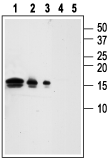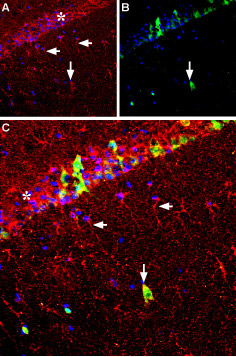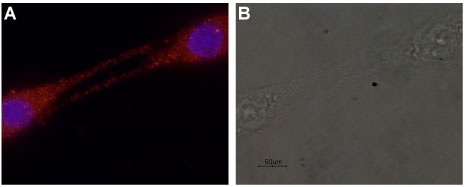Overview
- Peptide (C)DDNLVYHILRKHSAKR, corresponding to amino acid residues 192-207 of human GDNF (precursor) (Accession P39905). C-terminus of the mature GDNF.

 Western blot analysis of Recombinant human GDNF protein:Lanes 1, 4: 50 ng Recombinant human GDNF protein (#G-240).
Western blot analysis of Recombinant human GDNF protein:Lanes 1, 4: 50 ng Recombinant human GDNF protein (#G-240).
Lanes 2, 5: 10 ng Recombinant human GDNF protein.
Lanes 3, 4: 1 ng Recombinant human GDNF protein.
Lanes 1-3: Anti-GDNF Antibody (#ANT-014), (1:1000).
Lanes 4-5: Anti-GDNF Antibody, preincubated with GDNF Blocking Peptide (#BLP-NT014).
 Expression of GDNF in rat dorsal root ganglion (DRG).Immunohistochemical staining of rat DRG longitudinal frozen section using Anti-GDNF Antibody (#ANT-014), (1:50), followed by Alexa 555-conjugated goat anti-rabbit antibody (red). Hoechst 33342 (blue) was used as a counterstain. GDNF staining is specific for neurons. Note that Schwann cells as well as satellite glial cells are both negative.
Expression of GDNF in rat dorsal root ganglion (DRG).Immunohistochemical staining of rat DRG longitudinal frozen section using Anti-GDNF Antibody (#ANT-014), (1:50), followed by Alexa 555-conjugated goat anti-rabbit antibody (red). Hoechst 33342 (blue) was used as a counterstain. GDNF staining is specific for neurons. Note that Schwann cells as well as satellite glial cells are both negative. Expression of GDNF in rat hippocampusImmunohistochemical staining of rat hippocampus frozen sections with Anti-GDNF Antibody (#ANT-014), (1:100), (red). A. GDNF staining is apparent in the pyramidal layer (asterik), in astrocytic fibers (horizontal arrows) and in some interneurons (vertical arrow). B. Calbindin D28k (green) appears in a subset of cells in the pyramidal layer. C. Merge of GDNF and calbindin demonstrates some co-localization in neurons. DAPI is used as the counterstain (blue).
Expression of GDNF in rat hippocampusImmunohistochemical staining of rat hippocampus frozen sections with Anti-GDNF Antibody (#ANT-014), (1:100), (red). A. GDNF staining is apparent in the pyramidal layer (asterik), in astrocytic fibers (horizontal arrows) and in some interneurons (vertical arrow). B. Calbindin D28k (green) appears in a subset of cells in the pyramidal layer. C. Merge of GDNF and calbindin demonstrates some co-localization in neurons. DAPI is used as the counterstain (blue).
 Expression of GDNF in rat C6 glioma cellsImmunocytochemical staining of GDNF in rat C6 glioma cells. A. Paraformaldehyde-fixed and permeabilized rat C6 glioma cells were stained with Anti-GDNF Antibody (#ANT-014), (1:200) followed by goat anti-rabbit-AlexaFluor-555 secondary antibody (red). Nuclei were visualized with the cell-permeable dye Hoechst 33342 (blue). B. Live view of the same field as in (A).
Expression of GDNF in rat C6 glioma cellsImmunocytochemical staining of GDNF in rat C6 glioma cells. A. Paraformaldehyde-fixed and permeabilized rat C6 glioma cells were stained with Anti-GDNF Antibody (#ANT-014), (1:200) followed by goat anti-rabbit-AlexaFluor-555 secondary antibody (red). Nuclei were visualized with the cell-permeable dye Hoechst 33342 (blue). B. Live view of the same field as in (A).
- Lin, L.F. et al. (1993) Science 260, 1130.
- Airaksinen, M.S. and Saarma, M. (2002) Nat. Rev. Neurosci. 3, 383.
- Sariola, H. and Saarma, M. (2003) J. Cell Sci. 116, 3855.
- Paratcha, G. et al. (2003) Cell 113, 867.
Glial cell-line derived neurotrophic factor (GDNF) is a neurotrophic factor originally identified for its ability to promote the survival of dopaminergic neurons in the midbrain.1
GDNF is part of the neurotrophic factor family known as GDNF-family ligand (GFL), which includes neurturin (NRTN), artemin (ARTN), and persephin (PSPN).2,3 The GFL ligands are structurally related to the transforming growth factor-b (TGF-b) protein superfamily and contain seven cysteine residues with the same relative spacing as other members of this family.2
Typical of neurotrophic factors, GDNF is produced in the form of a precursor, preproGDNF, which is then cleaved during secretion to become proGDNF, and later processed to the mature (homodimeric) GDNF form.2
The GFLs convey their activity by binding to a multicomponent receptor that includes the RET receptor tyrosine kinase and a glycosyl phosphatidylinositol (GPI)-linked ligand-binding subunit known as GDNF family receptor α (GFRα).2,3 Four different GFRα subunits have been identified (GFRα 1-4) that determine the specificity of the GFRα-RET receptor complex. Thus, GFRα1 together with RET make up the high affinity receptor for GDNF.
The GDNF and GFRα complex interaction with RET induces activation of the intracellular tyrosine kinase domain of the latter. Phosphorylated RET can then interact with several intracellular signaling cascades including MAP kinase, PI3K and PLCγ signaling pathways.2,3
Lately a RET-independent signaling pathway for GDNF has been shown to involve binding of GDNF and GFRα to the neural cell adhesion molecule (NCAM). Signaling of GDNF via the NCAM complex stimulates intracellular tyrosine kinases such as Fyn and FAK.4
GDNF is synthesized and secreted by a wide variety of cell types in the central and peripheral nervous system where it exerts its neurotrophic effects in the development and maintenance of distinct sets of neurons. Accordingly, GDNF knockout mice die shortly after birth, reflecting the central role of GDNF in neurodevelopment.2
Remarkably, GDNF was found to be an essential morphogen for kidney formation as well as to have a role is spermatogenesis.3
Application key:
Species reactivity key:
Alomone Labs is pleased to offer a highly specific antibody directed against an epitope of human GDNF. Anti-GDNF Antibody (#ANT-014) can be used in western blot, immunocytochemistry, and immunohistochemistry applications. It has been designed to recognize GDNF from human, mouse and rat samples.
